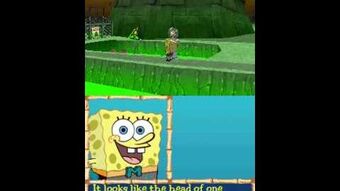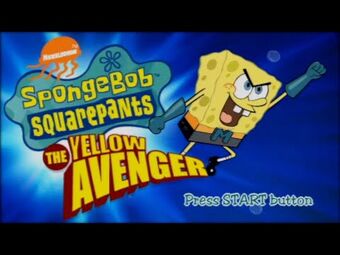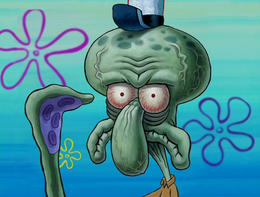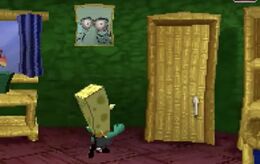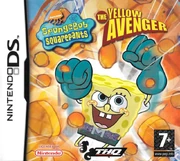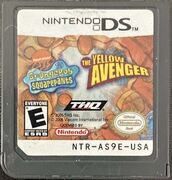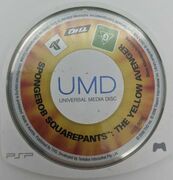The Yellow Avenger is a SpongeBob SquarePants video game that was released for the Nintendo DS in 2005 and for PlayStation Portable in 2006.
Plot[]
SpongeBob acquires Mermaid Man's powers when he wears his belt. Unfortunately, SpongeBob puts the Dirty Bubble into a washing machine, which causes him to split into countless dirty bubbles! SpongeBob has to stop villains such as Man Ray, the Sinister Slug, Jumbo Shrimp, Atomic Flounder, and the Dirty Bubble, using Mermaid Man's powers to save Bikini Bottom.
The story is divided into Acts, each with a different villain trying to wreak havoc on Bikini Bottom. Man Ray wants to flood Goo Lagoon, Sinister Slug's evil plan is to stop the talent show, Jumbo Shrimp, with the help of Plankton, creates a machine to shrink people the size of the latter on top of the Sea Needle, the Atomic Flounder causes chaos in the Industrial Park, and the Dirty Bubble returns to put the end of the Yellow Avenger with the machine the Jumbo Shrimp used in the third act and plans to hit SpongeBob with more little Dirty Bubbles.
Locations[]
- The Wash!
- Industrial Park
- Rock Bottom
- Rock Bottom bus station
- Mrs. Puff's Boating School
- Jellyfish Fields
- Restaurant District
- Snack Bar
- Ice Cream
- The Salty Spitoon
- Weenie Hut Jr's
- Super Weenie Hut Jr's
- Downtown Bikini Bottom
- The Mysterious Old Abandoned Factory
- Krusty Krab
- Chum Bucket
- Shady Shoals Rest Home
- SpongeBob's house
- Squidward Tentacles' house
- Residential District
- Sandy's treedome
- Kelp Forest
- Mermalair
- Sea Needle
- Reef Cinema
- Goo Lagoon
- Giant Anchor
- Life guard tower
- Goo Lagoon Pier
- Eugene H. Krabs and Pearl Krabs' house
- Betsy Krabs' house
This list is incomplete, but you can help Encyclopedia SpongeBobia by expanding it.
Differences between the DS version and the PlayStation Portable version[]
While both versions of the video game were both made by Tantalus Media, both versions are different.
- The DS version uses a lot of 2D objects while in the PSP version uses a lot of 3D backgrounds.
- On the DS version, the player needs to tap on the button screen to view the cutscenes. On the PSP version, the X button needs to be pressed instead.
- The PSP version has minigames while in the DS version does not.
- The PSP version has a lot of super power pods in the levels while the DS version has the same ones.
- The icons for SpongeBob and Dirty Bubble are different in both versions.
- Also in the DS version the icons for the three boss fights are in the bottom right corner while in the PSP version they are below SpongeBob's heath icon.
- In the PSP version, the bus sign is at SpongeBob's house but in the DS version version it's near the Restaurant District entrance and Sandy's treedome.
- In the DS version the player needed to drawn symbols while in the PSP version the player needed to push the buttons of the PSP.
- Near Shady Shoals Rest Home in the PSP version, there's a gate while in the DS version these was no gate.
- During the first cutscene in the DS version it plays the remix of the theme song, In the PSP version it plays the Restaurant District theme instead.
- When at Rock Bottom in the DS version, the skyblox has the same one as the Industrial Park while in the PSP version uses a different skyblox instead.
- When you miss up in the Jumbo Shrimp boss in the DS version, it will take you back to the entrance at the Sea Needle, but in the PSP version you will be back in the Sea Needle level.
- When fighting Jumbo Shrimp in the DS version, the music playing is the Rock Bottom music instead of the Man Ray and Dirty Bubble.
- Also in the DS version, Jumbo Shrimp does not look at SpongeBob when he is about to throw a box.
- In the Industrial Park level, the Atomic Flounder is located in the DS version while in the PSP version he near the bus stop.
- Some incidentals being pestered by little Dirty Bubbles have different color schemes in both versions.
- In the PSP version of the "help" section you get "Level Unlocking" and "Inactive Super Power Pads" this was never seen in the DS version.
Reception[]
On review aggregator Metacritic, the Nintendo DS version has a 67/100, indicating "mixed or average reviews,"[1] while the PlayStation Portable version has a 48/100, indicating "generally unfavorable reviews."[2]
Ed Lewis of IGN praised the graphics and music of the PSP version, but criticized its "sparse and uninspired" sound effects, as well as, "Confusing menus, lack of guidance, and the creepiest loading screen that's been seen in a long, long while." Lewis also criticized the repetitive gameplay, writing, "If the levels were linear and you went through the game once these would be a fun challenge, but there's lots and lots and lots of backtracking involved and much of it can't be skipped."[3]
Marc Nix of IGN wrote a positive review of the DS version, favorably comparing gameplay to Indiana Jones and the Fate of Atlantis for its "unique mix of action and exploring." Nix called the game "a visual treat" and praised it for utilizing the system's touchscreen to creatively interact with objects. However, Nix criticized the game for some difficult gameplay and for not utilizing voice-overs from the stars of the television series.[4]
Louis Bedigian of GameZone criticized the PSP version, writing that its worlds "feel empty" and that the game would only appeal to "kids with patience, kids who aren't bored by running and jumping in a bland environment." Bedigian praised some of the graphics, but criticized the game's long and repetitive loading times: "At least three of my first 15 minutes with this game were reserved for load times. That's potentially 12 minutes of loading for every hour of gameplay." Bedigian enjoyed the game's story but criticized the lack of voice-overs: "Without voice-overs, and with bland objectives that aren't overly fun, mission explanations are told through text. Lengthy, uninviting paragraphs that will surely turn off the game's target audience."[5]
Anise Hollingshead of GameZone wrote a positive review of the DS version, praising its humor, its voiceovers, its use of the DS touchscreen, and its graphics, writing that it "is drawn exactly like the TV show." Hollingshead noted that the addition of minigames would have increased the game's overall enjoyment and replayability, but wrote, "Exploration and conversation are what players will experience the most, which is a welcomed change from most handheld games. It’s fun to just explore with SpongeBob and talk to his silly friends."[6]
Walkthrough[]
Nintendo DS version[]
PlayStation Portable version[]
Backward compatibility[]
The game has backward compatibility on the following systems:
- Nintendo 3DS - The DS cartridge can be played to any of the 3DS family systems.
- PlayStation Vita - The digital version of the game bought from the PSP's PlayStation Store, prior to its closing, can be downloaded to the Vita. Similarly, the game can be bought directly through the Vita's own PlayStation Store.
- PlayStation TV - Every digital versions of PSP games that are compatible with the Vita are also compatible with PSTV.
Trivia[]
General[]
- This was the first SpongeBob video game to be released for both the Nintendo DS and PlayStation Portable.
- The DS version was also released as the Ultimate Fun Bundle, which also included a Nintendo DSi system and a SpongeBob 9-in-1 style kit.
- There is a picture on a wall in Squidward's house that resembles a screenshot from "Just One Bite." The pixelated picture shows the "Unsure Squidward" face that has become a popular Internet meme.
- The face can also be seen in Battle for Bikini Bottom and Battle for Bikini Bottom: Rehydrated.

"Unsure Squidward" in "Just One Bite."

"Unsure Squidward" in-game.[7]
- The face can also be seen in Battle for Bikini Bottom and Battle for Bikini Bottom: Rehydrated.
- In this game, SpongeBob shows how to make jellyfish jelly.
- After playing the game, the player unlocks a character viewer.
- It is revealed in the game that the Sea Needle is the tallest building in Downtown Bikini Bottom.
- Bubble Bass and Flats the Flounder were going to be in the game, but were removed.[8]
- SpongeBob can explore the Industrial Park from "Prehibernation Week," the Kelp Forest from "Club SpongeBob," and Rock Bottom from the episode of the same name.
- The little Dirty Bubbles are red, rather than the actual dirty brown color of the original Dirty Bubble.
- The game does not save after the player beats it. This is so the final boss battle can be played an infinite number of times. This also means that the percentage complete of a game file will always be at 99% and it will never reach 100%.
- When SpongeBob is in his room, if one looks closely, they can see under Gary's food bowl is the "Town Scared" newspaper from "Pranks a Lot."
- The PlayStation Portable version was later re-released in the PlayStation Portable Greatest Hits line in 2008. The same version was then re-released again in PAL countries as part of the PlayStation Essentials line.
- SpongeBob can make water balls like the ones Mermaid Man makes in "Mermaid Man and Barnacle Boy."
- This is the first SpongeBob game to be Rated 7 by the Pegi rating board.
- This game is similar to the 1990s video game franchise, Pandemonium!. Aside the fact that this and the said franchise use 2.5D graphics. The bosses are similar to each other because they mostly require puzzle solving-tactics to defeat each boss.
- This is the only SpongeBob PSP game to have an original story.
Errors[]
- The Reef Cinema is in town, but in the series, it has a path leading to the cinema, which separates it from the town.
- This error also occurs in the video games Legend of the Lost Spatula and SpongeBob SquarePants featuring Nicktoons: Globs of Doom.
International covers[]
Discs/Cartridges[]
External links[]
- Official Lights, Camera, Pants! website, including information about The Yellow Avenger
References[]
- ^ https://web.archive.org/web/20160329083023/http://www.metacritic.com/game/ds/spongebob-squarepants-the-yellow-avenger
- ^ https://web.archive.org/web/20170505101506/http://www.metacritic.com/game/psp/spongebob-squarepants-the-yellow-avenger
- ^ https://web.archive.org/web/20160428195151/http://www.ign.com/articles/2006/03/25/spongebob-squarepants-the-yellow-avenger
- ^ https://web.archive.org/web/20160917202414/http://www.ign.com/articles/2005/12/01/spongebob-squarepants-the-yellow-avenger-2
- ^ https://web.archive.org/web/20060420171055/http://psp.gamezone.com/gzreviews/r27131.htm
- ^ https://web.archive.org/web/20060531072737/http://nds.gamezone.com/gzreviews/r27131.htm
- ^ Nintendo DS Longplay [087] SpongeBob SquarePants The Yellow Avenger - YouTube
- ^ https://tcrf.net/SpongeBob_SquarePants:_The_Yellow_Avenger_(Nintendo_DS)#Unused_Graphics

|
This page uses content from Wikipedia (original • authors). Both Encyclopedia SpongeBobia and Wikipedia are licensed under the CC BY-SA 3.0 Unported license. |

